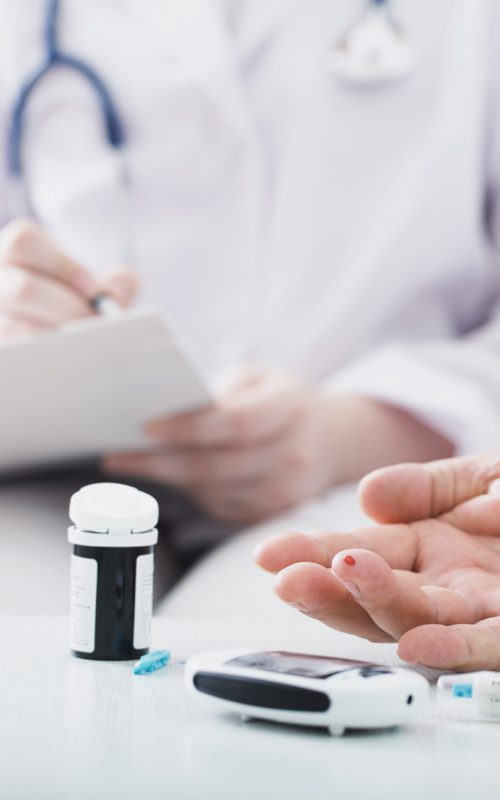Understanding diabetes: causes, symptoms and treatments
Diabetes is a chronic disease that affects millions of people around the world. It can have serious health consequences, but there are treatments to help manage symptoms and prevent complications. This comprehensive guide will help you understand the causes, symptoms and treatment options for diabetes.
WHAT IS DIABETES?
Diabetes is a chronic disease that affects the way the body processes glucose, or sugar, in the blood. It is a disorder of the absorption, use and storage of sugar from food.
When we eat, sugar levels in the blood rise and carbohydrates are essentially converted into glucose. The pancreas detects an increase in blood sugar. Beta cells in the pancreas, grouped in clusters called islets of Langerhans, secrete insulin. Insulin acts like a key, allowing glucose to enter the body’s cells: muscles, the adipose tissue body fat and the liver, where it can be converted and stored. Glucose levels in the blood then decreases.
Another hormone, glucagon, releases the glucose stored in the liver outside of meals, when there is a drop in energy or a drop in blood glucose, and it is the balance of these hormones that helps to maintain stable blood glucose levels in the body. In diabetes, this regulatory system does not work.
There are two main types: diabetes type 1, which is usually diagnosed in children and young adults, and diabetes type 2, which is more common in adults and is often linked to risk factors such as obesity and lack of physical activity.
Symptoms include excessive thirst, frequent urination, tiredness, blurred vision and frequent infections. Treatment may include lifestyle changes, medication and, in some cases, insulin.


DIFFERENT TYPES OF DIABETES
There are two main types of diabetes: diabetes type 1 and diabetes type 2.
Diabetes Type 1 is usually diagnosed in children and young adults and is caused by the destruction of insulin-producing cells in the pancreas. The cause of type 1 is unknown, but it is considered an autoimmune disease because the body’s immune system attacks and mistakenly destroys the insulin-producing cells in the pancreas. Treatment for diabetes type 1 involves taking two or more daily injections of insulin to help the body use glucose as an energy source. In some cases, you may also need to take oral medication or use an insulin pump to control your blood glucose.
Diabetes Type 2 is more common in adults and is often associated with risk factors such as obesity and lack of physical activity. In this type of the disease, the body does not produce enough insulin or cannot effectively use the insulin it produces. People often do not know they have the condition until they have serious complications. Some people may experience symptoms such as increased thirst or hunger, tiredness, frequent urination, blurred vision, tingling or numbness in the feet, sores that heal slowly, weight loss despite an increased appetite, and sores that take a long time to heal. Treatment for diabetes type 2 depends on the severity of the condition. In most cases, lifestyle changes such as a healthy diet and more exercise can help keep blood glucose levels in a healthy range. If these measures do not bring blood glucose levels back to target, medication may be needed to keep blood glucose levels at an acceptable level.
GESTATIONAL DIABETES
Gestational diabetes is a condition in which a woman with no history of diabetes becomes hyperglycaemic (high blood sugar) during pregnancy. Gestational diabetes is not the same as diabetes type 1 or type 2. It is diagnosed during pregnancy when a woman has hyperglycaemia that cannot be explained by other factors.
Gestational diabetes mellitus (GDM) is a type of diabetes that affects pregnant women and usually disappears after childbirth. Women who develop gestational diabetes have an increased risk of developing diabetes type 2 later in life. Therefore, women who have had gestational diabetes should work with their doctor to develop a plan to prevent or delay the onset of diabetes type 2 later in life.
DIABETIC RETINOPATHY
Retinopathy is a general term used to describe any disease of the retina (the light-sensitive tissue at the back of the eye). There are more than 30 different types of retinopathy that can affect vision to varying degrees.
The two most common forms of retinopathy are diabetic retinopathy and venous occlusion (blockage) of the blood vessels that supply blood to the retina.
Diabetic retinopathy occurs when diabetes affects the small blood vessels of the retina. Over time, these vessels become damaged and leak, which can lead to bleeding or swelling of the retina. In some cases, these blood vessels can heal or swell abnormally, distorting vision and leading to blindness if left untreated.
THE CAUSES
The causes of diabetes vary according to the type. Diabetes Type 1 is caused by the destruction of insulin-producing cells in the pancreas, often due to an autoimmune reaction. Diabetes Type 2 is often associated with risk factors such as obesity, lack of physical activity, heredity and ageing. In both types of diabetes, blood glucose levels are high, which can lead to long-term complications such as heart problems, nerve damage and vision problems.
THE SYMPTOMS OF DIABETES
Symptoms can vary depending on the type of diabetes and the severity of the condition. Common symptoms of diabetes type 1 include excessive thirst, frequent urination, unexplained weight loss, tiredness and blurred vision. Symptoms of diabetes type 2 can be similar, but may also include frequent infections, slow healing of wounds, and tingling or numbness in the hands and feet. If you have symptoms of diabetes, it is important to see a healthcare professional for appropriate diagnosis and treatment.
TREATMENT OPTIONS
Treatment options for diabetes depend on the type and severity of the condition. For diabetes type 1, treatment usually involves administering insulin by injection or pump. For diabetes type 2, treatment may include lifestyle changes such as regular exercise and a healthy diet, as well as medication to help control blood sugar levels. In more severe cases, surgery may be needed. It is important to work closely with a healthcare professional to determine the best treatment plan for your individual situation.


